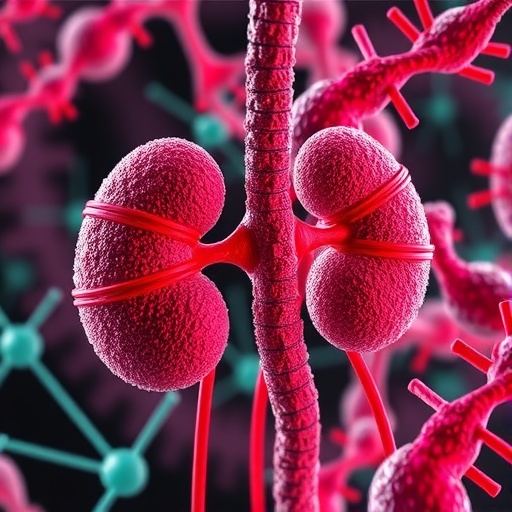In a groundbreaking study recently published in BMC Cancer, researchers have unraveled the intricate landscape of tRNA-derived small RNAs (tsRNAs) in clear cell renal cell carcinoma (ccRCC), shedding light on their dysregulation and potential as novel biomarkers for this aggressive form of kidney cancer. This investigation marks a pivotal advance in understanding the complex molecular mechanisms driving ccRCC, opening new avenues for therapeutic intervention.
TsRNAs, a class of small non-coding RNAs processed from transfer RNAs (tRNAs), have emerged as significant regulators of gene expression, akin to microRNAs and other small RNA species. Despite their critical roles in cellular processes, their involvement in ccRCC has remained largely unexplored until now. The research team undertook a comprehensive profiling of tsRNA expression, leveraging cutting-edge small RNA microarray sequencing technology to map their altered expression spectrum in tumor samples compared to normal adjacent tissues.
This extensive profiling revealed a striking dysregulation pattern: 433 tsRNAs were found to be significantly upregulated, while an even larger cohort of 798 tsRNAs was markedly downregulated in ccRCC tissues. Such profound alterations suggest that tsRNAs may play crucial roles in tumor biology, influencing cell proliferation, survival, and metastatic potential. To validate these findings, eight tsRNAs exhibiting the most pronounced differential expression were tested using reverse transcription-quantitative real-time PCR (RT-qPCR), confirming their aberrant expression profiles.
Crucially, the study delved deeper by predicting the target genes of these dysregulated tsRNAs using established bioinformatics databases, including TargetScan and miRanda. This predictive approach illuminated a network of mRNAs potentially regulated by tsRNAs, implicating them in pathways vital to cancer development. Functional annotation of these predicted targets via Gene Ontology (GO) and Kyoto Encyclopedia of Genes and Genomes (KEGG) analyses unveiled their involvement in key biological processes such as cell cycle regulation, apoptosis, and signal transduction pathways notorious for their roles in oncogenesis.
One tsRNA, in particular, tRF5-23-ValAAC-2, emerged as a promising biomarker with significant functional relevance in ccRCC progression. Its aberrant expression was consistently validated in external databases, reinforcing its potential as a diagnostic and prognostic tool. Functional assays further demonstrated that tRF5-23-ValAAC-2 exerts a tumor-suppressive effect by inhibiting ccRCC cell proliferation and migration, while concurrently promoting programmed cell death. These findings underscore the therapeutic potential of targeting specific tsRNAs to curb tumor growth.
While the molecular underpinnings of tsRNA biogenesis and function remain an evolving field, this study adds a critical piece to the puzzle by highlighting their multifaceted roles in renal tumorigenesis. The dysregulation of tsRNAs disrupts the delicate balance of gene expression, driving oncogenic pathways that facilitate tumor development and metastasis. This insight not only expands our comprehension of ccRCC pathophysiology but also suggests new molecular targets for intervention.
The use of high-throughput microarray sequencing coupled with rigorous validation methods sets a new standard for biomarker discovery in cancer research. By capturing the global tsRNA expression profile in ccRCC tissues, the researchers provided a rich dataset for further exploration. Importantly, integration with bioinformatics tools allowed precise identification of downstream targets, bridging the gap between tsRNA expression and functional consequences.
This comprehensive approach demonstrates that tsRNAs are not mere byproducts of tRNA degradation but active participants in the oncogenic circuitry. Their capacity to fine-tune gene expression post-transcriptionally positions them as master regulators within tumor cells. Moreover, the tissue-specific expression patterns of tsRNAs offer a unique window into tumor identity and behavior, enhancing the precision of future diagnostic assays.
The implications of this discovery extend beyond ccRCC. Since tsRNAs have been implicated in a variety of cancer types, the methodologies and findings from this study can be applied to broader oncological research. Identification of tsRNA signatures holds promise for refining patient stratification, predicting treatment response, and monitoring disease progression across diverse malignancies.
Future research will be essential to elucidate the mechanistic pathways through which tsRNAs influence tumor biology. Investigating their interactions with other non-coding RNAs, RNA-binding proteins, and epigenetic modulators will deepen understanding of their regulatory networks. Additionally, exploring tsRNA stability and secretion could pave the way for non-invasive biomarker development, leveraging bodily fluids such as blood or urine for early cancer detection.
The study also sets the stage for novel therapeutic strategies harnessing tsRNA modulation. Synthetic mimics or inhibitors of specific tsRNAs could be developed to restore normal gene regulation or suppress tumor-promoting pathways. Such approaches, currently under investigation for microRNAs, may find compelling parallels in tsRNA-targeted therapy.
In summary, this seminal work reveals the altered tsRNA landscape in clear cell renal cell carcinoma, identifies key regulatory tsRNAs such as tRF5-23-ValAAC-2, and elucidates their potential functional roles and clinical applications. The research not only advances the molecular understanding of ccRCC but also charts a promising course toward innovative diagnostics and treatments tailored to the unique RNA profiles of tumors.
As kidney cancer incidence continues to rise globally, insights from this study provide a beacon of hope for patients and clinicians alike. The exploitation of tsRNAs as biomarkers and therapeutic targets offers a cutting-edge avenue to improve outcomes and personalize medicine in ccRCC, a cancer type notorious for its heterogeneity and resistance to conventional therapies.
The integration of high-throughput omics, sophisticated bioinformatics, and functional assays exemplifies the future of cancer research—where multi-dimensional analysis unravels complex biological systems and translates findings into clinical breakthroughs. This research heralds a new era in understanding the small RNA world’s vast influence on cancer biology and underscores the vital importance of continued exploration into non-coding RNA species.
Subject of Research: Altered expression and functional roles of tRNA-derived small RNAs in clear cell renal cell carcinoma (ccRCC).
Article Title: Altered expression spectrum and target gene prediction of tRNA-derived small RNAs in clear cell renal cell carcinoma.
Article References:
Liu, S., Cao, H., Chen, B. et al. Altered expression spectrum and target gene prediction of tRNA-derived small RNAs in clear cell renal cell carcinoma. BMC Cancer 25, 1456 (2025). https://doi.org/10.1186/s12885-025-14646-3
Image Credits: Scienmag.com




